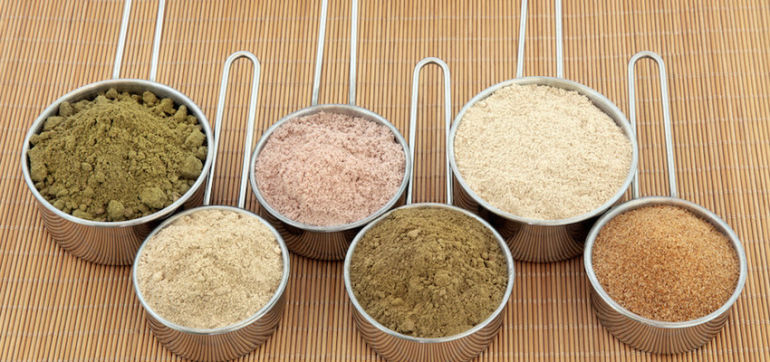How To Pick A Healthy Protein Powder

In making this choice, I instruct folks to focus on these five factors:
1. Purpose of powder
An important aspect to consider is the purpose of the protein powder ... Getting enough protein in your diet is going to be crucial to keeping metabolism up, stimulating fat loss, preserving your precious lean muscle mass, and improving your health overall.
For most women wanting to lose weight (and for those who don't have any special dietary restrictions), a standard whey protein powder will be sufficient for your needs. I consider whey protein isolates king among protein powders, and this is the type of protein supplement I primarily use. In fact, whether it comes to weight loss or muscle gain, hands down, whey protein is by far the most popular form of protein powder because of its amino acid profile and cost effectiveness.
2. Nutrition facts and ingredient list
When assessing a protein powder (or any food item for the matter) you should totally ignore the front of the package. I know, I know, the front of the package is usually so pretty and eye-catching. But that's how food manufacturers get you. So ignore the front. The nutritional info you really want to pay attention to is not on the front; it's on the back of the panel, which incidentally is the place few people read.
Guys, I can't stress enough how important it is that you get in the habit of reading food labels. Don't just trust a food item because it has the word "HEALTHY" plastered all over the front label in bold lettering and glitter.
When assessing a protein powder, it's very simple: First, you want to check out the Nutrition Facts on the back label for calories per serving, and then you want to assess the macronutrient breakdown. The three macronutrients are: fat, carbohydrates and protein. I usually opt for a whey protein powder with 120 to 140 calories per scoop. I also look for those that are low fat (less than 2 grams of fat per serving), low sugar (zero to no more than 1 gram of sugar per serving) and high protein (more than 25 grams of protein per scoop).
The next thing I look at is the ingredient list, which is typically found below the Nutrition Facts. When you look at an ingredient list, keep in mind that the ingredients listed first are the most abundant. The lower on the list the ingredient, the less of it there is in the product. (This rule applies to regular foods as well). When examining the ingredient list, I try to find a product that doesn't have a laundry list of ingredients.
As a general rule of thumb, I tend to gravitate to protein powders with no more than 10 to 12 ingredients. (Note: For protein blends, each type of protein is often listed, and I do not count each separate protein as a separate ingredient. I count all of the protein types together as one single ingredient.)
3. Amino acid profile
Amino acids are the building blocks of protein. The 20 amino acids found within proteins are separated into two categories: essential and non-essential amino acids. Essential amino acids cannot be created in the human body and must be obtained from food. Non-essential amino acids can be synthesized, or created, in the human body. There are nine essential amino acids. Since non-essential amino acids can be manufactured by the body, it's important to look for a protein powder with a good essential amino acid profile.
Branched-chain amino acids, also called BCAAs, refer to a chain of the three essential amino acids: leucine, isoleucine and valine. These three essential amino acids make up over one-third of skeletal muscle in the body and play a vital role in protein synthesis. So when selecting a protein powder, you want to pay close attention to whether the protein supplement contains leucine, isoleucine and valine. You can also look into purchasing stand-alone branched-chain amino acid supplements.
4. Sugar and sweetener content
Protein powders will often contain sweeteners and flavoring agents, which is not exactly the definition of "clean" foods. Still, there are in fact many high-quality protein powders that also contain sweeteners. The short and sweet (no pun intended) is to look for powders that have 1 gram (or zero grams) of sugar per serving, and scan the ingredients list for added sweeteners like stevia (a natural sweetener) or sucralose (an artificial one).
Honestly, I won't shun a protein powder just because it contains an artificial sweetener. I weigh things on a case-by-case basis. The choice is yours when it comes to artificial versus natural sweeteners. However, there is one type of sweetener I make no exception for in any protein supplement—high-fructose corn syrup (HFCS). If you see high-fructose corn syrup anywhere in the protein supplement ingredients, don't buy it!
5. Taste and mixability
For many folks, this is really what it's all about—taste! And who doesn't want a protein powder that tastes good?! Protein powders really have come a long way, and many brands make a variety of flavors that taste delicious. The best way to find the right one for you is obviously to sample a few. Stores like Whole Foods and Vitamin Shoppe sell single serving-size samples, so try those. And don't forget to ask your friend if you can bum a taste of her protein powder.
As far as mixability, you're looking at two options: shaker or blender. Will you need to make a protein shake when you're already out and about? Or, do you plan to be at home, in the presence of your handy-dandy blender? For those of you who need to throw together a shake while you're on the go, I'd suggest picking up an easy mixing powder (whey isolates tend to be the best as far as mixability). You'll also need an efficient way to mix the powder, and I find that shaker bottles work well. They're about $10 and completely worth it if you want to avoid the unpleasant taste of unmixed, dry protein powder in your shake. That said, if you have a blender and the time to use it, mixability won't be much of an issue.
Section from And That's Why You're Fat: Health & Fitness Mistakes to Stop Making by Dr. Phoenyx Austin. (c) 2014 by Dr. Phoenyx Austin and Dr. Phoenyx, LLC.
Photo Credit: Shutterstock
-
Vegetarian Weight Loss Tips - Lose Weight & Gain Health as a Vegetarian
Want to lose weight and gain health as a
-
5 WAYS TO CONTROL YOUR APPETITE - DO I HAVE REALLY HUNGRY?
The real trick to lose weight was added to eat less. But do not fee
-
Lose Weight Through Visualization
Are you tying to lose weight? Tried many
-
Over 50 and Starting To Sag - Fight Back with Isometric Exercise
As we age, the body and skin lose some o
-
Natural Weight Loss for Healthy Living
Considering the lifestyle we are living
-
How To Lose Belly Fat Latest Secrets From The Research Labs Part 2
Abdominal fat is now seen as a growing health hazard, an indicator and
- DON'T MISS
- Be At Your Best With Hagerstown Fitness Clinic
- WeightLoss How A Gusty Oversized Girl Shed Her Fat To Become Extremely Attractive
- Mens Ideal Weight
- How To Increase Your Metabolism For Maximum Weight Loss
- Eat Whole Foods When Traveling To Stay Slim
- Child Health, Obesity and The Puppy Fat Myth
- Get a Six Pack copying Tom Hanks
- Phentermine Side Effects
- Ingredients Of Fat Lose Diets
- Weight Loss Tips That Can Give You Back Your Figure




